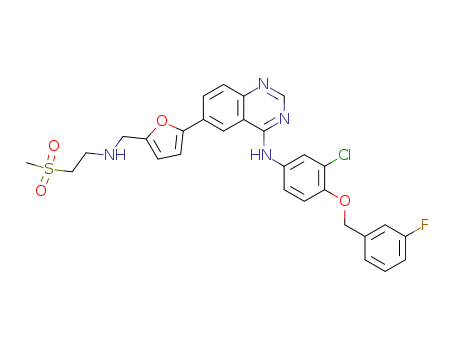
CasNo: 231277-92-2
Molecular Formula: C29H26ClFN4O4S
Appearance: Powder
|
Indications and Usage |
Lapatinib is a drug targeting breast cancer developed by British GlaxoSmithKline Co. Human ErbB receptors belong to the type I tyrosine kinase (TK) receptor family, including ErbB1 (EGFR), ErbB2 (HER2), ErbB3 (HER3), and ErbB4 (HER4). The ErbB-1 (EGFR) and ErbB-2 (HER-2) receptors are often overexpressed or otherwise altered in cancer patients. Human epidermal growth factor receptor 2 (ErbB-2, HER-2) is known to be a human oncogene closely related with breast cancer. Its high expression in breast cancer often predicts lymph node metastasis and poor tumor differentiation, with poor prognosis. HER-2 is one of the target molecules for breast cancer-specific therapy. Lapatinib can act simultaneously on both Her-1 Her-2. The biological effects of this method inhibiting the proliferation and growth of tumor cells are much larger than only acting on one target. The combination of Lapatinib with Capecitabine is used to treat patients with advanced or metastatic breast cancer with overexpression of human epidermal receptor2, already treated with anthracyclines, paclitaxel, and trastuzumab. Clinical trials have shown that Lapatinib also effectively treats HER2-type cancer patients with Herceptin resistance. |
|
Mechanisms of Action |
Lapatinib is a tyrosine kinase inhibitor which can effectively inhibit the tyrosine kinase activity of human epidermal growth factor receptors 1 and 2 (ErbB1, ErbB2). It can uniquely act in a variety of ways, ensuring that breast cancer cells cannot receive growth signals. It inhibits intracellular EGFR (ErbB-1) and HER2 (ErbB-2) ATP sites, preventing tumor cell phosphorylation and activation, blocking down-regulation signals through the homogeneity and heterogeneity of EGFR (ErbB-1) and HER2 (ErbB-1) dimerization. |
|
Description |
Lapatinib, a new member of the 4-anilinoquinazoline class of RTK inhibitors (RTKIs), was launched as an oral treatment for breast cancer. Lapatinib has dual affinity for EGFR and HER2 tyrosine kinases. It is indicated in combination with capecitabine for treating patients with advanced or metastatic breast cancer whose tumors overexpress HER2 and who have received prior therapy including an anthracycline, a taxane, and trastuzumab. Previously marketed drugs from the 4-anilinoquinazoline class include erlotinib (Tarceva) and gefitinib (IressaTM), both of which are indicated for treating non-small-cell lung cancer (NSCLC). As with erlotinib and gefitinib, To Market, To Market 2007 475 lapatinib is an ATP-competitive kinase inhibitor. It inhibits the tyrosine kinase activity EGFR and HER-2 with apparent Ki values of 3 and 13 nM, respectively, and has slow off-rate kinetics (t1/2X300 min). In addition, dividing the daily dose of lapatinib results in approximately 2-fold higher exposure at steady state compared to the same total dose administered once daily.The chemical synthesis of lapatinib entails the condensation of 4-chloro-6-iodoquinazoline and 3-chloro-4-(3-fluorobenzyloxy)aniline to produce a diaryl amine intermediate followed by Stille coupling of the iodo group with 5-dioxolanyl-2-(tributylstannyl)furan and subsequent acid hydrolysis of the cyclic ketal to the corresponding aldehyde. Finally, reductive amination of the aldehyde intermediate with 2-(methanesulfonyl) ethylamine in the presence of sodium triacetoxyborohydride produces lapatinib. . |
|
Originator |
GSK (US) |
|
Uses |
Lapatinib Ditosylate (GW572016, GW2016, Tykerb, Tyverb) is a potent EGFR and ErbB2 inhibitor with IC50 of 10.8 and 9.2 nM, respectively. |
|
Brand name |
Tykerb |
|
Drug interactions |
Potentially hazardous interactions with other drugs Antibacterials: avoid with rifabutin, rifampicin and telithromycin. Antidepressants: avoid with St John’s wort. Antidiabetics: avoid with repaglinide. Antiepileptics: concentration reduced by carbamazepine - avoid; possibly reduced fosphenytoin and phenytoin concentration - avoid. Antifungals: concentration increased by ketoconazole - avoid; avoid with itraconazole, posaconazole and voriconazole. Antipsychotics: avoid with clozapine (increased risk of agranulocytosis); avoid with pimozide. Antivirals: avoid with boceprevir, ritonavir and saquinavir. Cytotoxics: concentration of pazopanib increased; possible increased risk of neutropenia with docetaxel and paclitaxel; concentration of active metabolite of irinotecan increased, consider reducing irinotecan dose. Grapefruit juice: avoid concomitant us |
|
Metabolism |
Extensive hepatic metabolism, mainly by cytochrome P450 isoenzymes CYP3A4 and CYP3A5; CYP2C19 and CYP2C8 account for some minor metabolism. About 27% and 14% of an oral dose is recovered in the faeces, as parent lapatinib and metabolites, respectively; renal excretion is negligible. |
InChI:InChI=1/C29H26ClFN4O4S/c1-40(36,37)12-11-32-16-23-7-10-27(39-23)20-5-8-26-24(14-20)29(34-18-33-26)35-22-6-9-28(25(30)15-22)38-17-19-3-2-4-21(31)13-19/h2-10,13-15,18,32H,11-12,16-17H2,1H3,(H,33,34,35)
Single crystal growth of lapatinib free ...
The invention relates to a preparation m...
The present invention relates to an impr...
A through novel intermediate to prepare ...

2-Methanesulfonyl-ethylamine

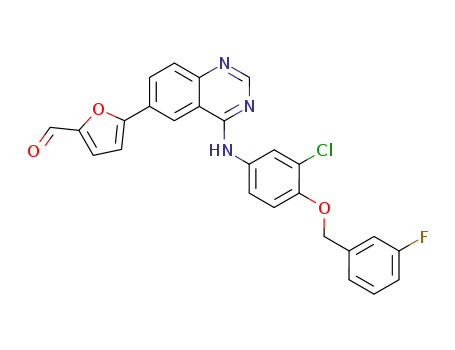
5-(4-(3-chloro-4-(3-fluorobenzyloxy)phenylamino)quinazolin-6-yl)furan-2-carbaldehyde

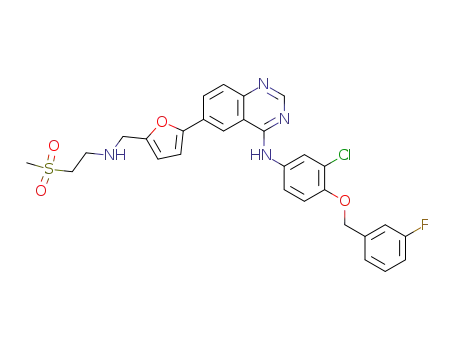
lapatanib
| Conditions | Yield |
|---|---|
|
2-Methanesulfonyl-ethylamine; 5-(4-(3-chloro-4-(3-fluorobenzyloxy)phenylamino)quinazolin-6-yl)furan-2-carbaldehyde; In methanol; dichloromethane; at 20 ℃;
With hydrogen; In methanol; dichloromethane; Inert atmosphere;
|
85% |
|
2-Methanesulfonyl-ethylamine; 5-(4-(3-chloro-4-(3-fluorobenzyloxy)phenylamino)quinazolin-6-yl)furan-2-carbaldehyde; With sodium tris(acetoxy)borohydride; N-ethyl-N,N-diisopropylamine;
With toluene-4-sulfonic acid;
|
80% |
|
2-Methanesulfonyl-ethylamine; 5-(4-(3-chloro-4-(3-fluorobenzyloxy)phenylamino)quinazolin-6-yl)furan-2-carbaldehyde; With triethylamine; In tetrahydrofuran; methanol; for 3h;
With methanol; sodium tetrahydroborate; In tetrahydrofuran; at 20 ℃; Cooling with ice;
|
70% |
|
With sodium tris(acetoxy)borohydride; acetic acid; In dichloromethane;
|
|
|
|
|
|
With triethylamine; In tetrahydrofuran; methanol; sodium borohydrid; water;
|
10.0 g(70%) |
|
|
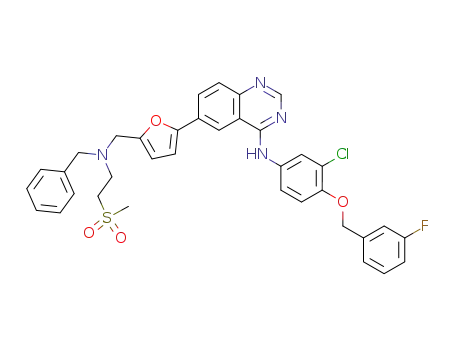
NEU-0000388


lapatanib
| Conditions | Yield |
|---|---|
|
With 20% palladium hydroxide-activated charcoal; hydrogen; In methanol; at 20 ℃; under 2585.81 - 2844.39 Torr;
|
81.67% |

2-Methanesulfonyl-ethylamine

5-(4-(3-chloro-4-(3-fluorobenzyloxy)phenylamino)quinazolin-6-yl)furan-2-carbaldehyde

3-chloro-4-(3-fluorobenzyloxy)nitrobenzene

4-chloro-6-iodoquinazoline
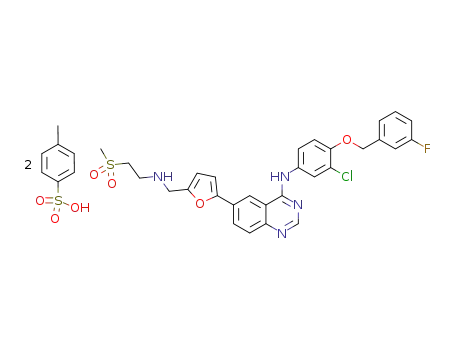
lapatinib ditosylate
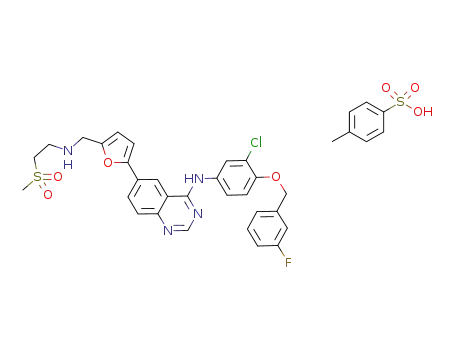
({5-[4-({3-chloro-4-[(3-fluorophenyl)methoxy]phenyl}amino)quinazolin-6-yl]furan-2-yl}methyl) [2-(methylsulfonyl)ethyl]azanium 4-methylbenzenesulfonate